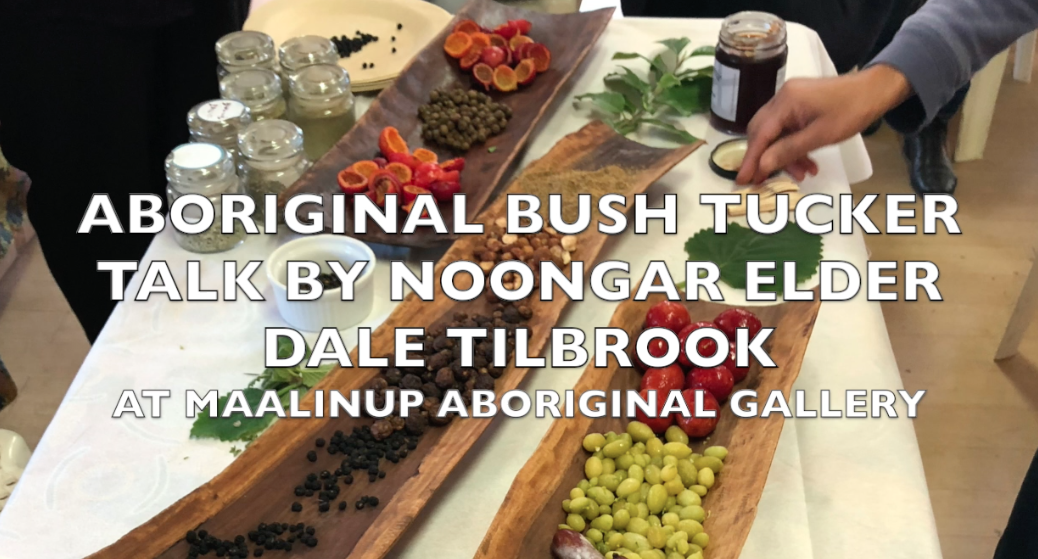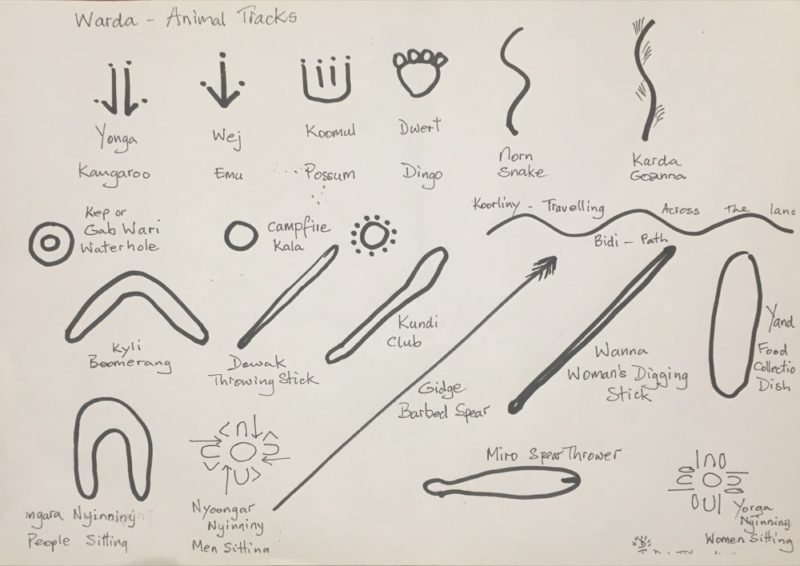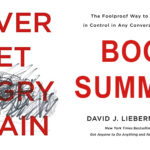
Aboriginal Bush Tucker Talk by Noongar Elder Dale Tilbrook
Summary under the video
Aboriginal Bush Tucker Talk by Noongar Elder Dale TilbrookAboriginal Dot Painting + Bushtucker Talk & Tastings by Dale (Link to Facebook event)
Notes:
– River myrtle – Called peppermint trees by the European settlers. Traditionally the green leaves were put over a fire and the aromas were inhaled. Same for specific woods and leaves for their medicinal benefits. You can inhale the steam by putting it in boiling water too.
– Fire was used to shape the landscape around the season of Birak.
– Birak: First summer.One of the 6 seasons for Noongar people. Around summer.
– Bunuru: Second summer.
– Djeran: When cooler weather begins. Autumn.
– Emus start laying their eggs Djeran. According to Aboriginal astrology, they see the galaxy as a giant emu and just as the emus start laying their eggs, the giant emu also appears in the night sky. They collect the eggs to blow the shell and the yolk is collected for cooking. The egg itself weights 600-900g and 10-12 in number. They taste more like a chicken egg. The people will also eat the long yams and back in the day, they had huge yam gardens along the swan river. The early settlers marked these areas on their map. Kangaroos and emus won’t go into the uneven ground because it’s too easy to break a leg which protected the yam gardens.

– The people move around according to season.
– Makuku: Winter. The emus will stop laying eggs. The male sits on them for 59 days and wont eat, drink or go to the loo until they hatch. Maybe just stretch his legs and rearrange the eggs. They will adopt orphan chicks as long as they’re smaller than their own. The eggs are a dark emerald like green colour. Every emu feather has 2 shafts.
– Kambaran: Late spring in Oct/Nov. This would be the sending session of tending the yam gardens.

– Dark Emu: Aboriginal Australia and the birth of agriculture by Bruce Pascoe is recommended as reading. She also mentions a 2 part series called Australia.
– One of the explorers wrote that the soil was as fine as ashes and smelled of roses. Especially where they grew murnong yams which had daisy flowers.
– When the British came, they declared the land as terra nullius (land belonging to no one). Some early depictions showed aboriginal people having tails. They are still the British colony where a treaty has never been made.

– Malcolm Turnbull sent a Statment from the Heart to Uluru to acknowledge aboriginal people. It said 3 things: Voice for aboriginal people, Treaty and the Truth of what happened to aboriginal people.
– The theme for NAIDOC this year will be ‘Always was, always will be’. If people can fight for same-sex marriage and acknowledge it, it’s way past time for Aboriginal people and history be acknowledged.
– Native spinach/warrigal greens: if you put it in your garden, it will keep popping back up.
– Geraldton wax: Flowers are not edible as they are waxy. You would use the leaves as they are citrusy. Mostly used for cooking fish. If you cook it with paperbark instead of alfoil you would cook it underground as the barbeque will burn it up. You can put some of it in the slits and cavities of fish to give it the smokey flavours.
– Bush basil: Not native to Western Australia but can be grown easily. Strong flavoured so blanche it first before cooking, that will take some of the oil out.
– Lemon myrtle: More powerful antifungal and antibacterial than tea tree. Much higher in calcium too. The food was their medicine so it was eaten as a preventative and curative.
– Pepper berry: They are hot and at first you’ll taste the aromatics, then you’ll get the heat at the back of your throat.
– Quandong: The major fruiting tree.
– Muntries: Apple flavoured berries.
– Bush tomatoes/Desert raisins: Intense caramelised raisin flavours and then the tomato taste comes out.
– Sandalwood nuts: The local tree nut. It’s so good for you. It was used for arthritis after being crushed and applied as a paste.
– Roasted wattle seed from acacia cyclops: A very nutty flavour. When it’s a dark roast it will take on the coffee mocha and hazelnut flavours. There are about 1100 different acacia species but only about 100 are edible. The pod twists and has ‘eyes’.
– Ruby lime/red centre lime: Hybrid courtesy of CSIRO from a finger lime and a rangpur lime. They have a grapefruit taste and tangy. Limes go from all sorts of colour from white to red to green. They would mostly be used a garnish. Other limes are finger limes, desert limes (very tangy and the great great great great grandma of all citrus), sunrise lime,
– Did you know all songbirds originated in Australia!?
You may also like:
– Noongar 6 Seasons and Bush Knowledge by Marissa Verma of Bindi Bindi Dreaming
– Noongar Culture Talk by Marissa Verma from Bindi Bindi Dreaming at Duncraig Edible Garden



